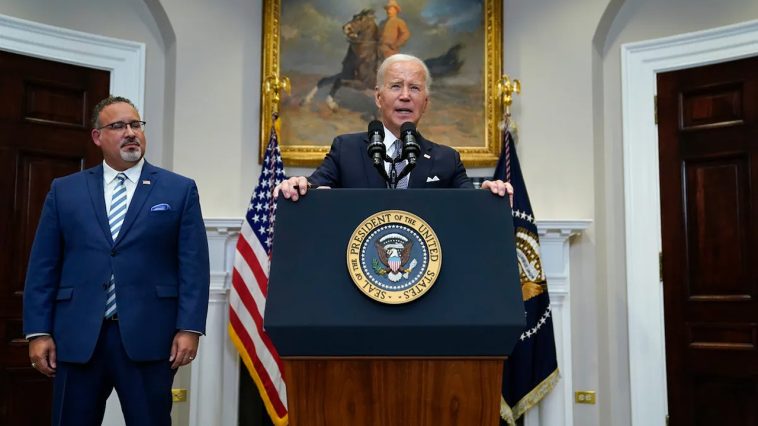LISTEN HERE:
In the wake of the Biden administration’s decision to lift the freeze on student loan payments this fall, close to 40% of borrowers overlooked their initial repayment, reveals a report by Politico. A close look at the figures from October 2019 shows that 26% of those due to make a payment fell short of doing so by the middle of November the same year.
A more recent snapshot taken in October 2023 reveals that out of the 22 million who were expected to make payments that month, nearly 8.8 million failed to settle their dues by mid-November.
Undersecretary of Education, James Kvaal, acknowledges these difficulties in a blog post published on a recent Friday. He expresses understanding for those who may feel muddled or daunted by their options and affirmed the Department’s commitment to assisting loan recipients.
He writes, ‘Despite the fact that a majority of borrowers have made their first payment, a significant number haven’t been able to yet. Some of them are simply bewildered by the process and need further clarity on their options. It’s crucial for them to know that our paramount focus is to provide support as they venture back into the repayment process.’
The Department of Education (ED) has implemented measures aiming at easing this transition. Last June, it announced that should borrowers neglect to pay, they would be neither reported to any credit agencies nor considered as defaulting before September 30, 2024. This leniency policy was brought to light in a blog post shared by the ED.
The administration has also faced legal backlash in its attempts to alleviate the student debt burden. In a notable decision, the Supreme Court ruled 6-3 against the Biden administration’s initiative aimed at forgiving student debt. The program intended to forgive loans for recipients of both Pell Grants and non-Pell Grants met its end in June.
In the subsequent days, on June 30, the ED unveiled plans to extend the reach of income-driven repayment plans. It is a clear indication of the ongoing efforts by the Department to devise strategies to manage student loan repayment.
Progress is also being made by using existing laws to sanction loan forgiveness. In a significant August announcement, plans were outlined to utilize the Higher Education Act to permit student loan forgiveness. This proposed plan would eliminate payments for individuals earning $32,800 or less annually, thus presenting a significant relief for lower-income borrowers.
Other plans to reduce the loan burden on long-term borrowers were unveiled in December. One notably interesting development is a program focused on public service workers, designed to relieve debt through the Public Service Loan Forgiveness scheme. This program caters to loan recipients who have been making repayments for upwards of 20 years, but have not received appropriate credit for their payments.
The Biden administration, according to a press statement released in December, has successfully executed debt forgiveness, affecting billions in student loans. The press release highlighted that as many as 3.6 million borrowers have had their loans entirely or partially forgiven.
From a detailed viewpoint, various programs have contributed to this significant relief. For instance, Public Service Loan Forgiveness has absolved close to $51 billion for about 715,000 borrowers.
Next, billions of dollars in loans have been pardoned through income-driven repayment schemes. To provide specifics, almost $42 billion worth of loan debt has been forgiven for approximately 855,000 borrowers enrolled in these repayment programs.
Finally, borrowers afflicted with disabilities have also benefited from these relief initiatives. Around $11.7 billion has been waived for nearly 513,000 such borrowers. These figures highlight the amplitude of the Biden administration’s efforts in student loan forgiveness.
However, with the extent of the forgiveness programs, questions arise on how effectively the ED has communicated with affected borrowers. The high volume of initial missed payments underscores the pressing need for transparency and comprehensive guides to navigate these newly created avenues for loan repayments.
Furthermore, while the administration has focused on forgiving billions in loan debt, it raises concerns about the financial implications for taxpayers. Discussions surrounding student loan forgiveness often overlook this angle, which should be factored into the wider conversation concerning public finance and education policy.
While the Department of Education pushes for these favorable initiatives, it is vital for borrowers to understand fully the specifics and potential implications of these programs. Adequate understanding is the first step towards making informed financial decisions concerning student loan repayments.
The importance of establishing an effective communication channel between the ED and the affected borrowers cannot be sufficiently underscored. Clear and easily accessible information about available repayment options can significantly simplify the process for borrowers and potentially alleviate financial stresses amongst this group.
As of this writing, the Department of Education has yet to offer any commentary regarding the Politico report or respond to requests for comment from the Daily Caller News Foundation.


